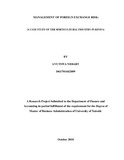| dc.description.abstract | Many currencies now float freely against each other and as a result, exchange rates
between different currencies can be volatile and thus leading to unpredictability of their
cash flows. As a consequence of the risk exposure from the above changes, the
management of the exchange rate risk is of key importance to firms that operate
internationally or that use debt finance. The objective of the study was to establish the
hedging techniques employed by the horticultural industry in Kenya. The data collection
tool was questionnaires that had both closed and open ended questions. The data was
analyzed using descriptive statistics with assistance of statistical package for social
sciences (SPSS). Output was then presented in terms of pie charts, graphs, frequency
tables and reports.
The study found out that the horticultural firms uses various techniques to manage the
risk which they face. The techniques they use include payment netting, prepayment,
leading and lagging and hedging with derivatives. The major reason found as to why the
horticultural firms hedge was found to be to cushion the firms against fluctuation in cash
flows, volatility in earnings, tax incentives of derivatives and maintenance of market
value. The firms were motivated to hedge by the need to was to reduce volatility in the
profit after tax, to reduce the volatility of cash flows, as an alternative means to manage
financial risks, firms with alternative means to manage foreign currency risks are likely to
use derivatives, to reduce risks faced by the management and to facilitate budgeting and
control process in the firm. | en |

